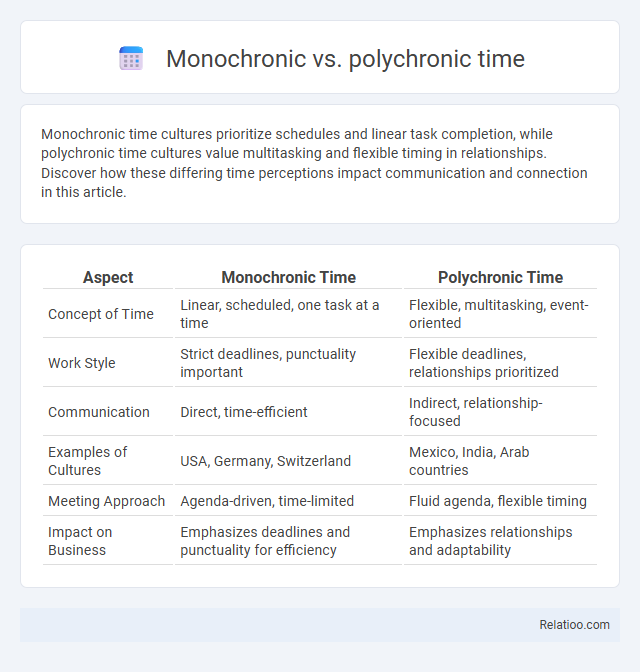Monochronic time cultures prioritize schedules and linear task completion, while polychronic time cultures value multitasking and flexible timing in relationships. Discover how these differing time perceptions impact communication and connection in this article.
Table of Comparison
| Aspect | Monochronic Time | Polychronic Time |
|---|---|---|
| Concept of Time | Linear, scheduled, one task at a time | Flexible, multitasking, event-oriented |
| Work Style | Strict deadlines, punctuality important | Flexible deadlines, relationships prioritized |
| Communication | Direct, time-efficient | Indirect, relationship-focused |
| Examples of Cultures | USA, Germany, Switzerland | Mexico, India, Arab countries |
| Meeting Approach | Agenda-driven, time-limited | Fluid agenda, flexible timing |
| Impact on Business | Emphasizes deadlines and punctuality for efficiency | Emphasizes relationships and adaptability |
Introduction to Time Perception: Monochronic vs Polychronic
Monochronic time emphasizes strict schedules and task completion, with a focus on punctuality and a linear approach to activities, while polychronic time values relationships, multitasking, and flexible scheduling. Understanding these contrasting time perceptions is crucial for effective intercultural communication, as they influence how individuals prioritize responsibilities and interact within different cultural contexts. Your ability to recognize and adapt to these time orientations can enhance cross-cultural interactions and reduce misunderstandings.
Defining Monochronic Time Orientation
Monochronic time orientation emphasizes a linear approach to time, valuing schedules, punctuality, and task prioritization within intercultural communication. Cultures with monochronic time orientation typically view time as a finite resource, preferring to focus on one activity at a time and adhering strictly to deadlines. Understanding this orientation is crucial for effective intercultural communication, as it contrasts with polychronic cultures that handle multiple tasks simultaneously and prioritize relationships over strict time management.
Understanding Polychronic Time Orientation
Understanding polychronic time orientation is crucial in intercultural communication as it emphasizes multitasking and flexible scheduling, contrasting sharply with monochronic cultures that value strict adherence to timelines and sequential task completion. Polychronic individuals prioritize relationships and interactions over rigid time constraints, often viewing time as cyclical and fluid rather than linear, which can affect meeting dynamics and negotiation strategies. Effective communication in intercultural settings requires recognizing these differences to avoid misunderstandings and foster collaboration between monochronic and polychronic time-oriented parties.
Key Differences Between Monochronic and Polychronic Cultures
Monochronic cultures prioritize strict schedules, linear task completion, and punctuality, emphasizing individual time management and deadlines. Polychronic cultures focus on multitasking, fluid schedules, and relationship-building, often valuating human interactions over rigid adherence to time. Understanding these key differences enhances intercultural communication by promoting respect for varying time perceptions and reducing potential conflicts in cross-cultural interactions.
Examples of Monochronic Time in Everyday Life
Monochronic time orientation is characterized by a focus on schedules, punctuality, and completing one task at a time, commonly seen in cultures like the United States and Germany. Examples in everyday life include strict adherence to meeting times, segmented work hours, and prioritizing deadlines in professional settings. This time structure contrasts with polychronic cultures where multitasking and flexible schedules are preferred, significantly impacting intercultural communication and expectations.
Examples of Polychronic Time in Daily Interactions
Polychronic time cultures, such as those in Latin America and the Middle East, prioritize multitasking and flexible scheduling, often engaging in multiple conversations or activities simultaneously during social or business meetings. In daily interactions, this manifests as overlapping discussions, frequent interruptions for personal matters, and a fluid approach to appointments where relationships take precedence over strict adherence to time. Such behaviors contrast with monochronic cultures and require intercultural communicators to adapt by valuing relational dynamics over punctuality to foster effective understanding.
Cultural Implications of Time Perception
Monochronic cultures prioritize punctuality, schedules, and completing one task at a time, which shapes clear communication expectations and respect for deadlines in intercultural interactions. Polychronic cultures view time as fluid, valuing relationships and multitasking over strict adherence to schedules, often leading to varying interpretations of time sensitivity and priorities during communication. Understanding these cultural implications of time perception enhances Your ability to navigate diverse communication styles, prevent misunderstandings, and foster effective intercultural dialogue.
Challenges in Cross-Cultural Communication
Monochronic and polychronic time orientations create significant challenges in intercultural communication by influencing individuals' perceptions of punctuality, scheduling, and task prioritization. Monochronic cultures prioritize linear, segmented time and strict adherence to plans, whereas polychronic cultures emphasize flexible scheduling and multitasking, often leading to misunderstandings and frustration in cross-cultural interactions. Effective communication requires awareness of these temporal differences to navigate conflicting expectations around deadlines and meeting structures.
Adapting to Different Time Orientations in Global Workplaces
Adapting to different time orientations in global workplaces requires understanding monochronic cultures, which emphasize punctuality and sequential task completion, and polychronic cultures, which prioritize multitasking and flexible schedules. Effective intercultural communication involves recognizing these time-related values to reduce conflicts and enhance collaboration among diverse teams. Training programs that highlight such temporal differences foster respect and improve productivity in multinational organizations.
Conclusion: Embracing Diverse Time Perspectives
Embracing diverse time perspectives enhances intercultural communication by fostering greater understanding and respect between monochronic and polychronic cultures. Recognizing that monochronic cultures prioritize strict scheduling and sequential task completion while polychronic cultures value multitasking and flexible time management helps reduce misunderstandings. Adapting communication strategies to accommodate these differences promotes collaboration and builds stronger intercultural relationships.

Infographic: Monochronic vs Polychronic time
 relatioo.com
relatioo.com